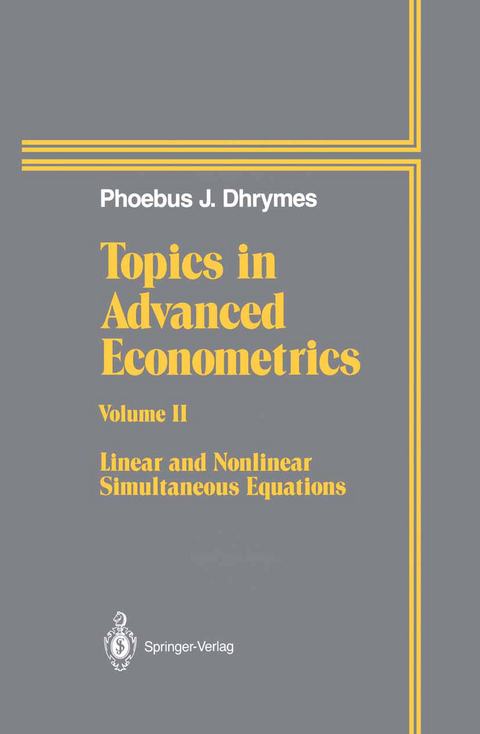
Topics In Advanced Econometrics
Springer-Verlag New York Inc.
978-0-387-94156-1 (ISBN)
This book is intended for second year graduate students and professionals who have an interest in linear and nonlinear simultaneous equations mod els. It basically traces the evolution of econometrics beyond the general linear model (GLM), beginning with the general linear structural econo metric model (GLSEM) and ending with the generalized method of mo ments (GMM). Thus, it covers the identification problem (Chapter 3), maximum likelihood (ML) methods (Chapters 3 and 4), two and three stage least squares (2SLS, 3SLS) (Chapters 1 and 2), the general nonlinear model (GNLM) (Chapter 5), the general nonlinear simultaneous equations model (GNLSEM), the special ca'3e of GNLSEM with additive errors, non linear two and three stage least squares (NL2SLS, NL3SLS), the GMM for GNLSEIVl, and finally ends with a brief overview of causality and re lated issues, (Chapter 6). There is no discussion either of limited dependent variables, or of unit root related topics. It also contains a number of significant innovations. In a departure from the custom of the literature, identification and consistency for nonlinear models is handled through the Kullback information apparatus, as well as the theory of minimum contrast (MC) estimators. In fact, nearly all estimation problems handled in this volume can be approached through the theory of MC estimators. The power of this approach is demonstrated in Chapter 5, where the entire set of identification requirements for the GLSEM, in an ML context, is obtained almost effortlessly, through the apparatus of Kullback information.
1 Extension of Classical Methods I.- 1.1 Introduction.- 1.2 A Brief Historical Review.- 1.3 The Nature of the GLSEM.- 1.4 The GLSEM: Assumptions and Notation.- 1.5 Inconsistency of OLS Estimators.- 1.6 Two Stage Least Squares (2SLS).- 1.7 Three Stage Least Squares (3SLS).- 1.8 Restricted 2SLS and 3SLS Estimators.- 1.9 Tests of Prior Restrictions.- Appendix to Chapter 1.- 2 Extension of Classical Methods II.- 2.1 Limiting Distributions.- 2.2 Forecasting from the GLSEM.- 2.3 The Vector Autoregressive Model (VAR).- 2.4 Instrumental Variables (IV).- 2.5 IV and Insufficient Sample Size.- 2.6 k-class and Double k-class Estimators.- 2.7 Distribution of LM Derived Estimators.- 2.8 Properties of Specification Tests.- Appendix to Chapter 2.- 3 Maximum Likelihood Methods I.- 3.1 Introduction.- 3.2 The Identification Problem.- 3.3 ML Estimation of the RF.- 3.4 FIML Estimation.- 3.5 Simplified FIML Estimators.- 3.6 Properties of Simplified Estimators.- 3.7 Limiting Distribution of FIML.- 4 LIML Estimation Methods.- 4.1 The “Concentrated” Likelihood Function.- 4.2 The Single Equation LIML Estimator.- 4.3 Consistency of the LIML Estimator.- 4.4 An Interesting Interpretation of LIML.- 4.5 Indirect Least Squares (ILS).- 4.6 Relation of LIML to Other Estimators.- 4.7 Limiting Distribution of LIML Estimators.- 4.8 Classic Identifiability Tests.- Appendix to Chapter 4.- 5 Nonlinear ML Methods.- 5.1 Motivation.- 5.2 A Mathematical Digression.- 5.3 Aspects of Likelihood Functions.- 5.4 Fisher Information.- 5.5 The Cramer-Rao Bounds.- 5.6 Martingale Properties of Likelihood Functions.- 5.7 Kullback Information.- 5.8 Convergence A.C. of ML Estimators.- 5.9 The General Nonlinear Model (GNLM).- 5.10 The GNLM with Restrictions.- 5.11 Tests of Restrictions.- 6 Topics in NLSE Theory.- 6.1Nonlinear ML.- 6.2 Nonlinear 2SLS.- 6.3 Nonlinear 3SLS.- 6.4 GMM.- 6.5 Causality and Related Issues.
| Erscheint lt. Verlag | 7.1.1994 |
|---|---|
| Zusatzinfo | XVIII, 402 p. |
| Verlagsort | New York, NY |
| Sprache | englisch |
| Maße | 156 x 234 mm |
| Themenwelt | Wirtschaft ► Volkswirtschaftslehre ► Ökonometrie |
| ISBN-10 | 0-387-94156-8 / 0387941568 |
| ISBN-13 | 978-0-387-94156-1 / 9780387941561 |
| Zustand | Neuware |
| Haben Sie eine Frage zum Produkt? |
aus dem Bereich


